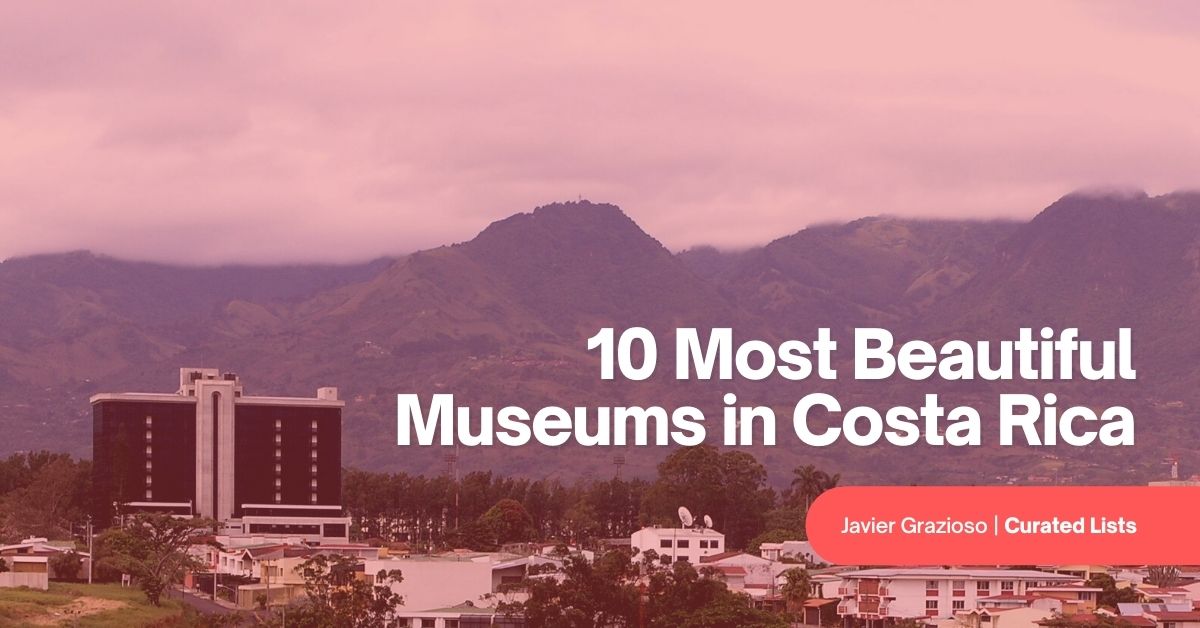
10 Most Beautiful Museums in Costa Rica
Museums in Costa Rica might be more than you think. This Central American country hosts a lot of museums.
While many people know Costa Rica for its hiking places, how their people love to say pura vida, its different flora and fauna, Costa Rica (alongside Mexico) has a lot of nice museums to visit.
I had the opportunity to visit one personally, and the place was beautiful, complete, and full of culture (and gold!) in the middle of San José. There is a special offer if you want to visit the three museums in San José, which will cost you 33 USD and you will be able to visit different museums on different days with the same ticket, which you can buy in any ticket office of one of the three museums.
If you are ready to visit some museums in Costa Rica, before booking your ticket, get comfortable, start scrolling down and join me, discovering all of these hidden jewels in Costa Rica.
PRO TIP: While the currency in Costa Rica is the Costa Rican Colón, many museums and other places accept USD due to the elevated tourism.
1. Pre-columbian Gold Museum
- Location: Bajos de la Plaza de la Cultura. Avenida Central. Calle 5 San José Centro San José CR 10104, Av. Central, San José, Costa Rica
- Main extraordinary feature: The Costa Rican indigenous tribes’ mythology
- Opening days and hours: Monday to Sunday 9:15 a.m. to 5 p.m.
El museo de oro precolombino (The pre-columbian gold museum) is “the best museum in Costa Rica thanks to its infrastructure, how organized it is, and the clarity with which they exhibit the materials,” said Alejandro Campos, a Costa Rican student who visited the museum over 5 times. I had the opportunity to visit it during my 12-hour stay in Costa Rica and it was fascinating—it made me learn about Costa Rican indigenous tribes, biodiversity, art and of course, its gold too!
The Museum has 4 floors and you have to go all the way to the bottom floor to start. There, you will find several golden artifacts that many pre-columbian tribes handcrafted. Visiting the museum will take you roughly two or three hours and you will learn a lot, not only about gold but about all the biodiversity that Costa Rica has to offer, the Costa Rican indigenous tribes’ mythology (in an amazingly peculiar language), Costa Rican contemporary art, and the history of Costa Rica’s currency.
The entrance fee is 15 USD (9,000 Colones).
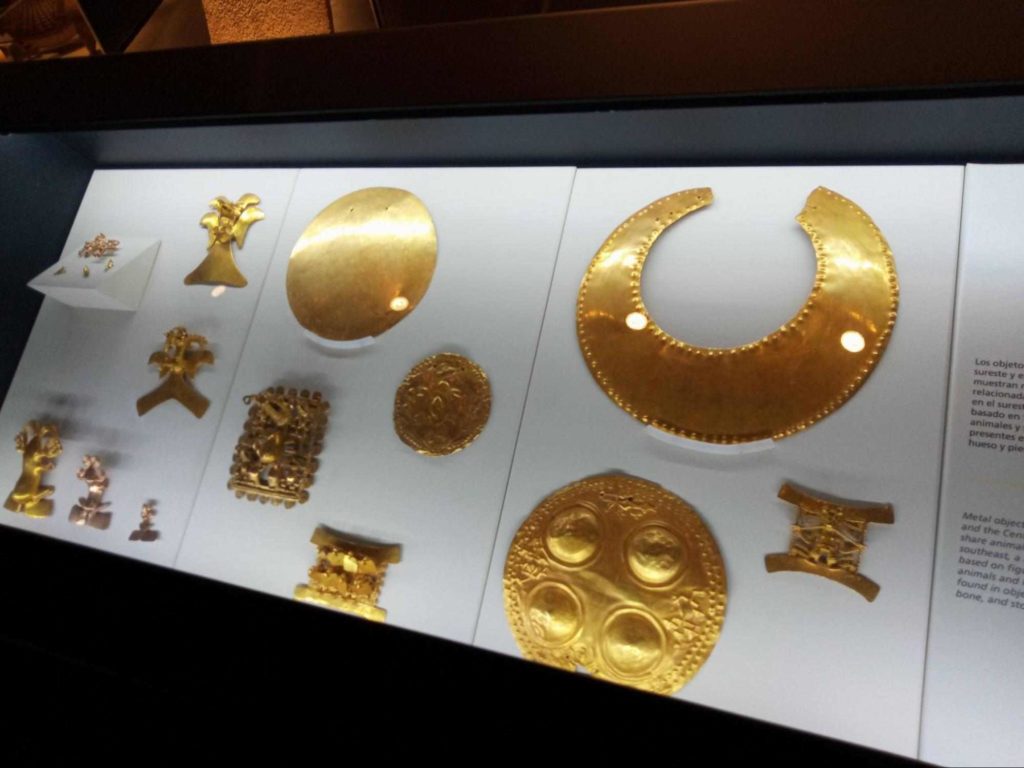
2. National Museum of Costa Rica
- Location: Avenidas Central y Segunda, contiguo a la Plaza de la Democracia y la Abolición del Ejército. San José, Costa Rica
- Main extraordinary feature: Its huge collection of assets and variety
- Opening days and hours: Tuesday to Saturday from 8:30 a.m. to 4:30 p.m. Sundays from 9 a.m. to 4:30 p.m.
El museo nacional de Costa Rica (the National Museum of Costa Rica) is one of the oldest ones that there is. It is one of the many museums in San José, Costa Rica. Costa Rican president then, Bernardo Soto, established it on May 4th, 1887! The museum is inclined towards scientific investigation, education, exhibitions and defense and conservation of Costa Rica’s natural and cultural heritage.
The National Museum of Costa Rica has been in its current location since 1950. It changed buildings three times in its history: once between 1887 and 1896, then between 1896 and 1903 and finally between 1903 and 1949.
In this museum you can find exhibitions on three main topics:
- Archeology – Arqueología
- Natural History – Historia Natural
- History of Costa Rica – Historia de Costa Rica
In the archeology section you can find different subsections like: cerámica (ceramics), lítica (lithics), metalurgia (metallurgy), restos humanos (human remains), restos faunísticos (faunal remains) and restos florales (floral remains).
If you decide to check the section on History of Costa Rica you are going to find more than 39,000 assets going back all the way to the age of the Colony. These assets are divided into obras de arte (artworks), indumentaria (clothing), equipos y herramientas de trabajo (work and equipment tools), documentos y fotografías (documents and photographs) and more!
Finally, in the Natural History section, you are going to find a ton (literally) of things! Including the biggest collection of arthropods in Central America, with more than 3,200,000 specimens!
The Natural History Museum of Costa Rica has it all! And if you don’t buy the ticket that I previously mentioned, as a foreigner, you can still access the place for 7 USD, or 5 USD if you’re a student!

3. Archeological Park “Alma Ata”
- Location: CV8G+VP9, Heredia, Sarapiquí, Costa Rica
- Main extraordinary feature: being an outdoor museum
- Opening days and hours: The hotel is open 24/7
El parque Arqueológico Alma Ata (the archeological park Alma Ata) is one of the coolest museums in Costa Rica. Although it is not technically a museum, it has the best of both worlds, a lot of assets, and pieces of cultural heritage to behold, while enjoying the tropical rainforest in Costa Rica.
The park is inside an orange plantation, in the domains of the Sarapiquis Rainforest Lodge hotel. Inside the orange plantation, someone found precolumbian tombs of at least 600 years. The park offers four different topics:Siglo XV de Costa Rica; la reconstrucción de montículos, calles y área de mercado de una villa indígena (Costa Rica in the 15th century: the reconstruction of mounds, streets and the market area of an indigenous village), esculturas precolombinas en piedra (pre columbian sculptures in stone), cementerio precolombino (pre columbian cemetery) and Petroglifos; una reconstrucción de un escenario con piedras –réplicas de un área de petroglifos (Petroglyphs: a reconstruction of a stone scenario – replicas of a petroglyph area).
If you want to stay in the hotel you’d have to pay 110 USD a night for a single or double room, and 136 USD for a triple one. If you want to take the tour in the archeological park, you have to pay 18 USD, and if you want to include lunch the fee is 28 USD.

4. Jade and Pre-Columbian Culture Museum
- Location: costado Oeste de Plaza de la Democracia, sobre Avenida Central, Calle 13 y 13 bis, San José, Costa Rica
- Main extraordinary feature: Its jade collection
- Opening days and hours: Monday to Sunday from 9 a.m. to 5 p.m.
El museo del Jade (the Jade museum) is one of the coolest ones in Costa Rica for its impressive jade collection. On October 31st, 1977 el instituto nacional de seguros (the National Institute of Insurances) opened the Jade Museum with more than 7,000 pieces of jade!
In the permanent exposition section of the museum you can find five different halls, all of which have a different topic and perspective:
| English | Spanish |
| jade hall | sala el jade |
| day hall | sala el día |
| night hall | sala la noche |
| memory hall | sala memoria |
| gathering hall | sala acopio |
In the jade hall, you can learn about the social, religious, and spiritual power that jade had in pre-Columbian societies, as well as its symbolism. In the day hall, you are going to learn about the everyday activities of pre-Columbian people, as well as their social organization and more.
In the night hall, you are going to learn about the underworld, the bat as a mythological animal, war, and funeral rituals. In the memory hall, you are going to learn about tools, artifacts, and clothing of the pre-Columbian people. In the gathering section, you are going to find objects belonging to the three greater regions of Costa Rica.
The entrance fee to this amazing museum in Costa Rica is 16 USD.
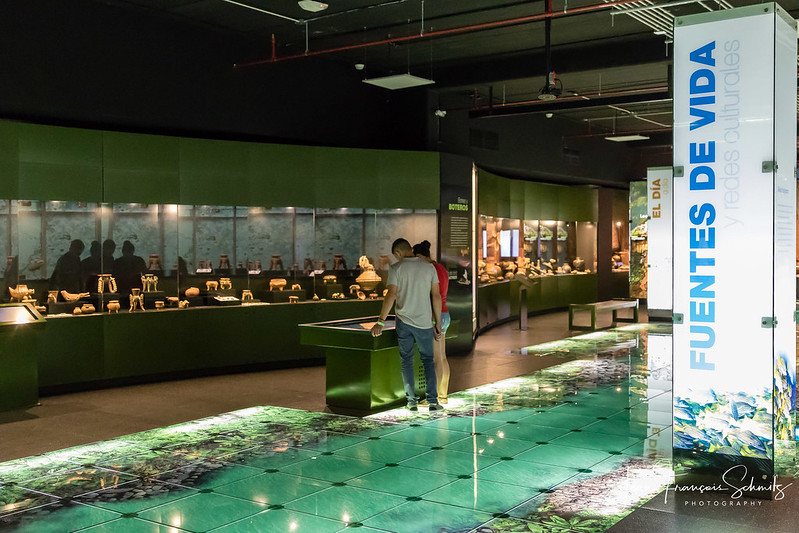
5. Kids’ Museum
- Location: Calle 4, Avenida 9, San José, Costa Rica
- Main extraordinary feature: The dinosaur exhibition
- Opening days and hours: Tuesdays to Sundays from 9 a.m. to 2 p.m.
El museo de los niños (the kids’ museum) is one of the best museums in Costa Rica to visit if you want to have a ton of fun.
It was born on April 27th, 1994 thanks to Costa Rica’s first lady at the time Gloria Bejarano de Calderón, inspired by the Kids’ museum in Venezuela. This made the kids’ museum in Costa Rica become the first one in Central America and the fourth one in Latin America!
The kids’ museum has more than 40 halls that you can visit with your kids. Among these there are 8 that the public loves:
| English | Spanish |
| bright smiles | sonrisas brillantes |
| Earth | tierra |
| experimenting with electricity and telecommunications | experimentando con electricidad y telecomunicaciones |
| Kal-yök television studio | el estudio de televisión kal-yök |
| let’s play archeologist | juguemos al arqueólogo |
| mundosaurio | mundosaurio |
| Museíto’s and Museíta’s house | la casa de Museíto y Museíta |
| super smart | súper inteligente |
There are three different entrance fees. Kids under 15 pay 3.13 USD (2,000 colones), people over 15 pay 3.44 USD (2,200 colones), and if you want to visit the old penitentiary museum next to the kids’ museum the entrance fee is 5.47 USD (3,500 colones.)
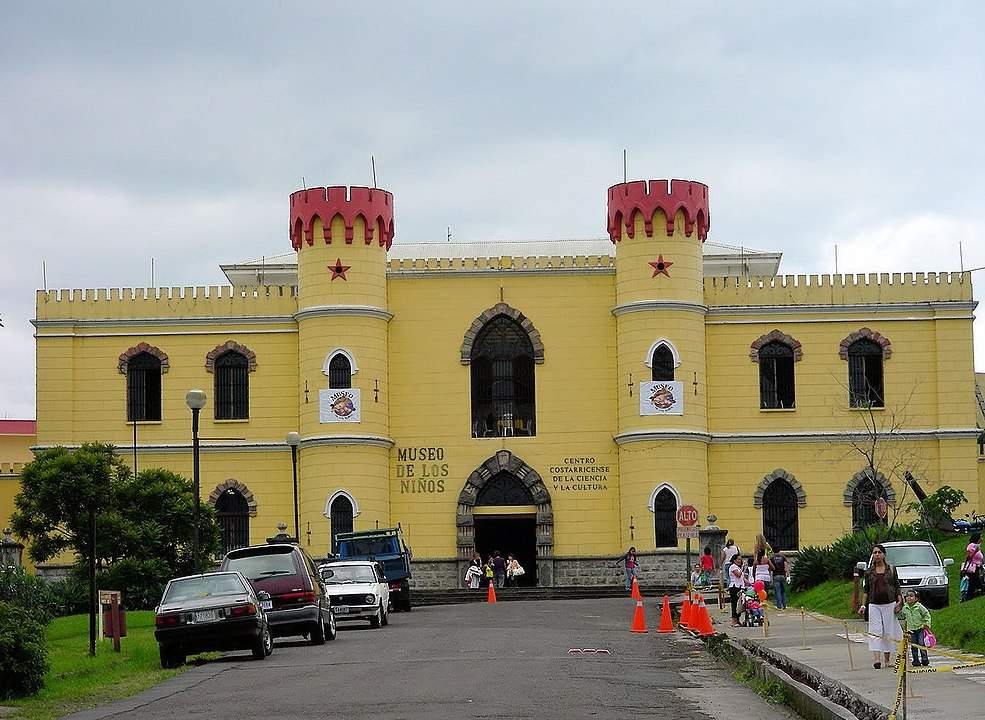
6. Costa Rican Art Museum
- Location: C. 42, Sabana, San José, Costa Rica
- Main extraordinary feature: More than 6,000 pieces
- Opening days and hours: Tuesday to Sunday from 9 a.m. to 4 p.m.
El museo de arte costarricense (Costa Rican Art Museum) is the best art museum in Costa Rica if you are looking for pure art! In this museum you can find paintings, sculptures, and photographs from Costa Rican and international artists between the 1850s up until the 2000s.
You can find more than 1,700 different paintings that Costa Ricans made. On the international side, you can find 560 pieces that foreign artists made.
The biggest part of the museum is the Juan Manuel Sánchez collection. Juan Manuel Sánchez was a Costa Rican poet, drawer, teacher, and sculptor. In 1998 his wife, Berta Solano, donated over 4,000 pieces of the Costa Rican artist to the museum, broadening the collection wildly, and making it the most important museum in Costa Rica in terms of art.
There is no entrance fee for this museum, it is free to access it.

7. Turtle Museum
- Location: Estación Biológica John H. Pipps de la Caribbean Conservation Corporation (CCC) en Tortuguero, Roxana, Pococí, Limón, Costa Rica
- Main extraordinary feature: Its turtles
- Opening days and hours: Monday to Sunday from 10 a.m. to 12 p.m. and from 2:30 p.m. to 5 p.m.
El museo de la tortuga (the Turtle Museum) is not the most popular museum in Costa Rica per se, but it is an amazing place for nature lovers.
The museum is in the Costa Rican province of Limón, close to San José. In this place you are going to learn all about tortugas (turtles) and tortugas marinas (marine turtles), including their hábitat natural (natural habitat), their vida (life) and el motivo para protegerlas (the reason to protect them). This is one of the coolest ecotourism activities that you can do in Costa Rica
The entrance fee to the museum is 2 USD, and it is a donation to keep the turtle project.
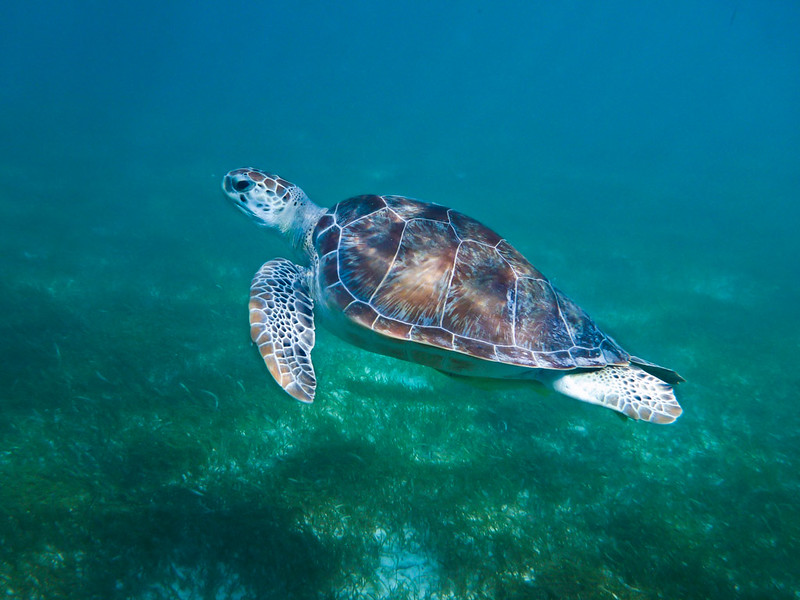
Read more: 12 ways to enjoy ecotourism in Panama
8. Islita Contemporary Art Museum
- Location: Islita, Bejuco, Nandayure, 50906, Guanacaste, Costa Rica
- Main extraordinary feature: Conjugating renowned and local artists
- Opening days and hours: 24/7. But the tours operate from 8 a.m. to 3 p.m.
El museo de arte contemporáneo al aire libre “punta islita” (Islita Contemporary Art Museum) was born in 2003 and it is currently part of the Consejo Internacional de Museos (International Museum Council – ICM) and it is thank to the Punta Islita Hotel initiative that the museum stands today.
The coolest part about this museum is that it hosts the art of Costa Rican artists alongside local community members in an outdoor display. This is because the owners of Punta Islita Hotel noticed that there were problems in the community and wanted to boost the community to promote tourism accordingly. Since its creation in 2003, it has hosted more than 15 exhibitions of local and invited artists. It is a true sustainable art project in Costa Rica.

9. La Salle Natural Sciences Museum
- Location: Sabana Sur, San José, Costa Rica
- Main extraordinary feature: Over 65,000 assets in permanent exhibition
- Opening days and hours: Wednesday to Saturday from 8 a.m. to 4 p.m. and Sundays from 9 a.m. to 5 p.m.
El museo de Ciencias Naturales La Salle (La Salle Natural Sciences Museum) is another cool museum in Costa Rica to visit. Eduardo Fernández, a science teacher in the La Salle school in Costa Rica, opened it in 1960, starting with his high school student’s projects.
In this museum you can find seven different sections:
| English | Spanish |
| birds | aves |
| entomology | entomología |
| fish and reptiles | peces y reptiles |
| malacology | malacología |
| mammals | mamíferos |
| minerals and rocks | minerales y rocas |
| paleontology | paleontología |
The bird section holds more than 1,460 different birds. The entomology section has more than 8,600 butterflies. The malacology has 15,000 items of more than 4,700 species of mollusks. You can find around 400 mammals. A lot of different rocks and minerals, different replicas of fossils, and a 16-foot (5-meter) stingray.

10. Historical and Cultural Museum Juan Santamaría
- Location: Av. 1, Provincia de Alajuela, Alajuela, Costa Rica
- Main extraordinary feature: 1856-1857 historical feat
- Opening days and hours: Tuesdays to Sundays from 9 a.m. to 5 p.m.
El museo histórico y cultural Juan Santamaría (Historical and Cultural museum Juan Santamaría) is a museum in Costa Rica that specializes in the 1856-1857 historical feat of Costa Rica and the war against the filibusters that invaded the land in those years. This museum has 360 art pieces, 106 of which are available online.
This is a very specific Costa Rican museum and it is worth visiting because it prepares different activities for its visitors such as:
| English | Spanish |
| academic activities | actividades académicas |
| academic and recreational shops | talleres académicos y recreativos |
| dancing | danza |
| guided visits | visitas guiadas |
| historical commemorations | conmemoraciones históricas |
| itinerant expositions | exposiciones itinerantes |
| music | música |
| plays | obras de teatro |
| poetry | poesía |
| temporary expositions | exposiciones temporales |
There is no entrance fee to this museum in Costa Rica

Learn Spanish Before Visiting Costa Rica
Costa Rica is a wonderful place to visit and has a lot of excellent museums to broaden your cultural library. The best way, though, to enjoy these museums is by knowing Spanish! Sign up for a free Spanish class today and open up the doors to fully and freely explore Costa Rica and other 21 countries!
Did you know that you could make your trip to Costa Rica easier by learning Spanish? That’s because you can earn more money by speaking it! But even if you’re still struggling with doubts before visiting Costa Rica, Spanish will help you to talk to more than 53,000,000 people all over the U.S.
Homeschool Spanish Academy has more than 24,000 students enrolled monthly and that’s because we offer earned high school credit, flexible scheduling, and great payment options!

Want to learn more about Latin America? Check out our latest posts!
- 15 Mouth-Watering National Dishes of Latin America
- 60 Best New Year Quotes in Spanish 2024
- The End of the Year Vacation Guide 2023 You Were Looking For
- Top Productivity Apps to Try For Language Learning
- 5 Educational Video Games to Practice Spanish
- Top 10 Hispanic Museums to Visit
- Best Tablets For Kids 2023 Edition
- Top 7 Countries to Study Abroad in Latin America
- 9 Tips for Learning How to Learn Two or More Languages at Once - January 20, 2023
- The History and Tradition of Las Cabañuelas - December 26, 2022
- 10 Ways to Learn How to Think in Spanish - December 25, 2022




